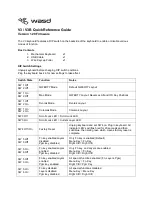
FXAlg #13: Stereo Hall
Algorithm Reference-24
FXAlg #13: Stereo Hall
A stereo hall reverberation algorithm
Allocation Units:
3
The Stereo Hall reverberation is implemented using a special arrangement of all pass networks and delay lines,
which reduces coloration and increases density. The reverberator is inherently stereo with each input injected into
the ÒroomÓ at multiple locations. To shorten the decay time of low and high frequencies relative to mid frequencies,
bass equalizers and lowpass filters, controlled by Bass Gain and by HF Damping, are placed within the network.
Room Size scales all the delay times of the network (but not the Pre Dly or Build Time), to change the simulated
room dimension over a range of 10 to 75m. Decay Time varies the feedback gains to achieve decay times from 0.5
to 100 seconds. The Room Size and Decay Time controls are interlocked so that a chosen Decay Time will be
maintained while Room Size is varied. At smaller sizes, the reverb becomes quite colored and is useful only for
special effects. A two-input stereo mixer, controlled by Wet/Dry and Out Gain, feeds the output. The Lowpass
control acts only on the wet signal and can be used to smooth out the reverb high end without modifying the reverb
decay time at high frequencies.
Simplified block diagram of Stereo Hall.
Within the reverberator, certain delays can be put into a time varying motion to break up patterns and to increase
density in the reverb tail. Using the LFO Rate and Depth controls carefully with longer decay times can be beneficial.
But beware of the pitch-shifting artifacts which can accompany randomization when it is used in greater amounts.
Also within the reverberator, the Diffusion control can reduce the diffusion provided by some all pass-networks.
While the reverb will eventually reach full diffusion regardless of the Diffusion setting, the early reverb diffusion
can be reduced, which sometimes is useful to help keep the dry signal Òin the clearÓ.
The reverberator structure is stereo and requires that the dry source be applied to both left and right inputs. If the
source is mono, it should still be applied (pan centered) to both left and right inputs. Failure to drive both inputs
will result in offset initial reverb images and later ping-ponging of the reverberation. Driving only one input will
also increase the time required to build up reverb density.
L Input
R Input
PreDelay
PreDelay
Dry
Dry
Out Gain
Wet
Reverb
L Output
R Output
















































